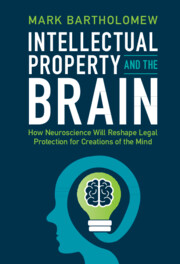 Intellectual Property and the Brain
Intellectual Property and the Brain from Part I - The Law and Neuroscience of Creative Activity
Published online by Cambridge University Press: 14 July 2022
Neuroscientific studies of the creative process reveal that artistic ingenuity is not the black box the law supposes it to be. These studies explode several popular myths about art and artists—myths that courts have used to justify their failure to truly interrogate creativity. The courts tend to believe in the creativity of novices, romanticizing the artistic potential of children and the mentally ill. Instead, the science reveals a strong correlation between expertise, learned skills, and creative output. Western societies assume that creativity arrives in a flash of insight, often when the artist is not even thinking about the project at hand; the truth is that creative breakthroughs take sustained effort and motivation. Rather than being incapable of outside understanding, various aspects of creative thought—including the generation of new visual imagery—can now be identified via changes in brain chemistry. The chapter uses copyright cases concerning a variety of works—from fine art to photography to Barbie dolls—to illustrate the flawed ways in which courts try to discern artistic creativity and how they might be reconceptualized in light of neuroscientific discoveries.
To save this book to your Kindle, first ensure [email protected] is added to your Approved Personal Document E-mail List under your Personal Document Settings on the Manage Your Content and Devices page of your Amazon account. Then enter the ‘name’ part of your Kindle email address below. Find out more about saving to your Kindle.
Note you can select to save to either the @free.kindle.com or @kindle.com variations. ‘@free.kindle.com’ emails are free but can only be saved to your device when it is connected to wi-fi. ‘@kindle.com’ emails can be delivered even when you are not connected to wi-fi, but note that service fees apply.
Find out more about the Kindle Personal Document Service.
To save content items to your account, please confirm that you agree to abide by our usage policies. If this is the first time you use this feature, you will be asked to authorise Cambridge Core to connect with your account. Find out more about saving content to Dropbox.
To save content items to your account, please confirm that you agree to abide by our usage policies. If this is the first time you use this feature, you will be asked to authorise Cambridge Core to connect with your account. Find out more about saving content to Google Drive.